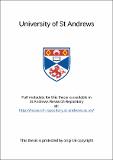Synthesis, characterisation and catalytic applications of mesocaged solids
Abstract
The synthesis of mesoporous materials has been investigated using a variety of liquid crystal surfactant systems as structure directing agents. Syntheses have been conducted in acid and basic media and at a variety of temperatures ranging from -4°C to 100°C and using different surfactant concentrations in order to control the resulting mesophase and its morphology. The mesoporous materials made have been characterised extensively using High Resolution Transmission Electron Microscopy (HRTEM), Scanning Electron Microscopy, X-ray diffraction, adsorption-desorption isotherms of various gases (nitrogen, w-hexane, cyclopentane, and mesitylene) and solid state Nuclear Magnetic Resonance (NMR). Hence, the morphology, structure and pore characteristics of known mesoporous materials SBA-1, SBA-2 and novel mesoporous materials, STA-10 (hexagonal, P6₃/mmc) and STA-11 (cubic, Ia3d), have been characterised. Results have yielded interesting information on the bimodal nature and dimensions of cages in SBA-1, the cage window size of SBA-2 and its cubic polytypic intergrowth STAC-1, their structural defects and their potential use as heterogeneous catalysts. The mesoporous phase STA-11, synthesised using triblock polymer PEO-PPO-PEO as a template displays one of the largest unit cells yet reported and has a cubic structure similar to that of MCM-48. This material has been extensively studied by HRTEM. In addition, we have explored the incorporation of heteroatoms (aluminium and titanium) into mesoporous molecular sieves, leading to the formation of tetrahedral catalytic active sites within the internal surface area of the mesopores via direct and post synthesis procedures. The active sites have been characterised using ²⁷A1 MAS NMR and Ti-EXAFS, respectively. These materials have been tested as catalysts for, among others, the epoxidation of cyclohexene and 1-octene (for those with titanium as the active site) and in the alkoxylation of a-pinene and limonene, and the skeletal isomerisation of butene (for those samples with aluminium as the active sites). Improvement of conversions and selectivity to the desired product has been achieved by post-synthetic treatment of the heteroatom-incorporated materials, for example treatment with ammonia for aluminium samples.
Type
Thesis, PhD Doctor of Philosopy
Collections
Items in the St Andrews Research Repository are protected by copyright, with all rights reserved, unless otherwise indicated.

